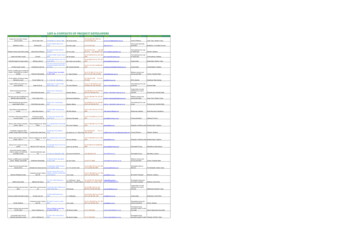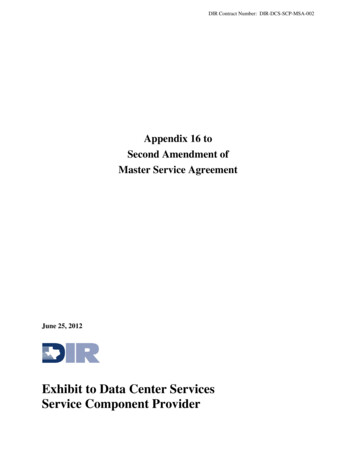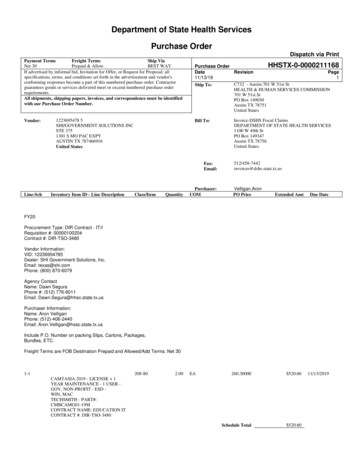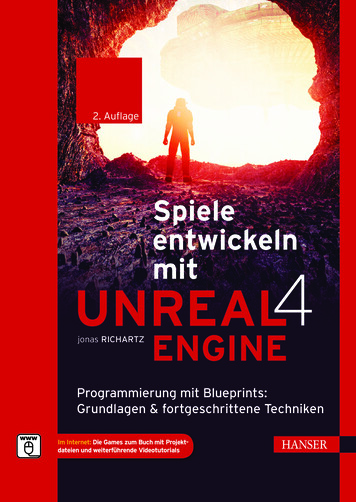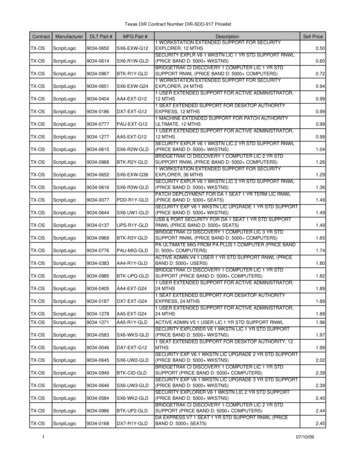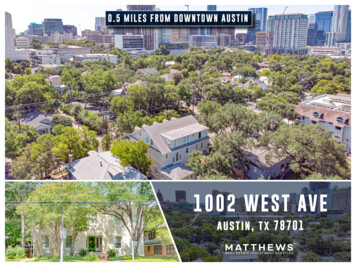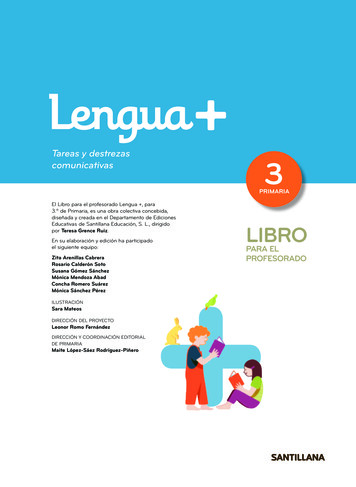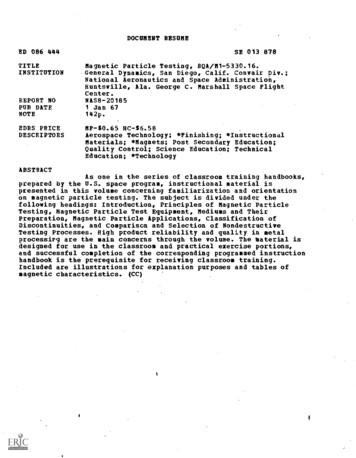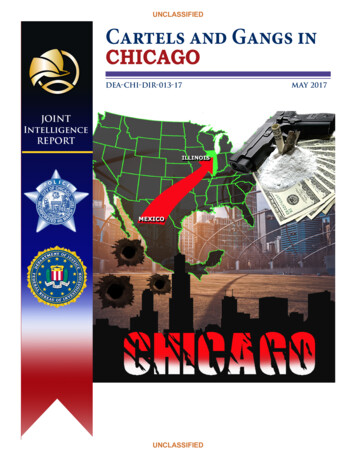
Transcription
CARTELS AND GANGS IN CHICAGOUNCLASSIFIEDCartels and Gangs 1UNCLASSIFIEDMAY 2017
CARTELS AND GANGS IN CHICAGOExecutive SummaryChicago has a long history of organized crime and is home to numerous street gangs that usethe illegal drug trade to build their criminal enterprises. Although the murder rate in Chicagohas declined significantly since the 1990s, recent instances of gang-related homicides haveplaced Chicago’s crime situation in the national spotlight. Compounding Chicago’s crimeproblem is a steady supply of drugs from Mexican drug cartels, most notably the Sinaloa Cartel.Illicit drugs flow from Mexico to Chicago via a loosely associated network of profit-drivenintermediaries, with Chicago street gangs serving as the primary distributors at the street level.The profits earned through drug trafficking increase the staying power of both street gangs anddrug trafficking organizations (DTOs), thereby influencing levels of violent crime in both theUnited States and Mexico. Of particular concern is the trafficking and distribution of heroin,which has increased significantly in recent years and caused significant harm to communitiesin Chicago and throughout the United States. This report provides background on the gangrelated crime situation in Chicago and offers insight on the nexus between Mexican DTOs andChicago street gangs.DetailsCHICAGO’S DRUG SITUATIONThe drug trafficking threat in Chicago encompasses virtually every aspect of the threat facingour nation—wholesale supply, transshipment, distribution, use, and money laundering—all ofwhich are occurring at very high levels. The vast majority of illegal drugs distributed in Chicagoare supplied by Mexican cartels, including the Sinaloa Cartel, Beltran-Leyva Cartel, Gulf Cartel,La Familia Michoacana, the Guerreros Unidos, and the Cartel de Jalisco Nueva Generación.At this time there do not appear to be any viable competitors to Mexican DTOs for control overthe wholesale-level supply of illegal drugs to the Chicago area.According to the Drug Enforcement Administration’s (DEA) 2016 National Drug ThreatAssessment, Mexican DTOs control all drug trafficking across the Southwest Border (SWB)and continue to expand their presence in the United States. Mexican DTOs are poly-drugin nature and are responsible for the vast majority of cocaine, heroin, methamphetamine,and marijuana trafficked into the United States. These organizations maintain a very largenetwork of family and friends throughout the United States who often help facilitate drugtrafficking operations. Mexican DTO members actively seek to maintain a low-profile to avoiddetection by law enforcement entities.1 In Mexico, the competitive advantages of the cartelsare influenced heavily by geography. For example, the Sinaloa Cartel controls large swaths ofterritory in western Mexico where the majority of poppy cultivation and heroin production takeplace. By comparison, the Gulf Cartel and Los Zetas control lucrative smuggling corridors intosouth Texas.2To move their drug shipments to Chicago, Mexican cartels often employ a series ofintermediaries who oversee the shipment of drugs across the SWB and facilitate sales towholesale and mid-level customers. These key intermediaries are most often based in theUnited States but maintain close relationships with family members or associates in Mexicoinvolved in cartel operations. For cartel leadership, these individuals are very beneficialbecause of their ability to broker drug deals and facilitate smuggling operations, and becausethey help insulate cartel members in Mexico by assuming a majority of the risk and thwartinglaw enforcement’s efforts to directly trace the supply of drugs back to sources in Mexico.The vast majority of drugs entering the Chicago area continue to be smuggled across theU.S.–Mexico border and transshipped via various transportation methods to Chicago andsurrounding areas. The Chicago area’s extensive highway, train, and air transportationsystems (including mail and parcel delivery services) make it an ideal transportation hub to2
UNCLASSIFIEDAlong with many other cities in the United States, Chicago has seen a remarkable increasein the availability and abuse of heroin in recent years. This increase is evidenced by heroinseizure data, an increasing number of heroin-related overdoses, and the number of individualsseeking treatment or medical care for heroin abuse. The vast majority of the heroin consumedin Chicago is supplied by Mexican cartels that have expanded their role in the U.S. heroinmarket by producing more heroin and supplying markets throughout the country.3 Large,multi-kilogram seizures of heroin are increasingly common and occur on a relatively frequentbasis. Typically, seizures of this magnitude would be expected to cause some disruption inthe supply of the drug to the street, with fluctuations in price, purity, or both. However, despitethe increase in seizures and the volume of the drug seized, the price and purity of retail-levelheroin in Chicago has remained relatively low and stable in recent years, indicating that theoverall increased supply has allowed the gangs to continue selling relatively low-purity herointo maximize profits. The distribution of fentanyl, either in place of or in combination with heroin,has likely helped stretch the overall supply of heroin and has increased the lethality of drugssold on the street.Regarding heroin abuse trends, the percentage of individuals seeking treatment for heroinabuse in Chicago is among the highest in the nation. For example, in 2012, the percentageof treatment admissions for heroin in the Chicago Metropolitan Area was more than doublethe national average (35.1 percent vs 16.4 percent). From 2007-2012, there were significantincreases in treatment admissions despite a significant decline in treatment capacity in Illinois.In 2011, the most recent year for which data are available, the Chicago Metropolitan Area alsoranked first in the country for the total number of emergency department visits related to heroinuse (24,627)—nearly double the number for New York City, a city with more than three timesthe population of Chicago.4It appears that heroin availability in the Chicago area is being driven equally by both supply anddemand, given that increases in production and seizures are occurring simultaneously with asteady and growing demand for the drug. Overall, the threat that heroin poses to the Chicagoarea is significant not only for the many dangers it brings to public health, but also because itprovides criminal groups and violent street gangs with a means to generate significant profitsthrough numerous and recurring street-level sales, which in turn may bring additional harm tothe community through subsequent disputes or turf battles over this highly lucrative illegal trade.The increase in heroin trafficking, availability, and abuse is influenced by a number of factors,including an increase in the number of abusers who switch to heroin from prescription opioids,and a more concerted effort by Mexican DTOs to produce and distribute heroin. The latter islikely influenced by a general decline in the availability and use of cocaine in the United Statessince 2007.CHICAGO’S MOST PREVALENT STREET GANGSChicago is home to several street gangs that are heavily involved in drug distribution, violentcrime, and other criminal activity. The primary street gangs that pose the greatest threat inthe Chicago area are the Gangster Disciples, Black Disciples, Black P Stone Nation, ViceLords, and Latin Kings. Other significant street gangs that are active in Chicago, each with anestimated membership of over 1,000, include the New Breeds, Four Corner Hustlers, Two Six,Maniac Latin Disciples, Satan Disciples, Spanish Cobras, and Mickey Cobras. Although gang3UNCLASSIFIEDCARTELS AND GANGS IN CHICAGOmove drugs from the SWB to Chicago and throughout the Midwest, as well as the subsequentcollection of drug proceeds in Chicago and movement of bulk currency to the SWB. The mostcommon transportation method remains by vehicle—typically tractor-trailers, trucks, buses, and/or personal vehicles. The transportation routes and smuggling methods used often depend onthe amount and type of drug being trafficked. Drugs may be transported directly from Mexico toChicago, or from Mexico to staging points inside the US where the shipments are broken downfor onward transport to distributors in other areas of the country. Chicago serves as both astaging point and a final destination for drug shipments arriving from Mexico.
CARTELS AND GANGS IN CHICAGOmembership is difficult to pinpoint, local authorities estimate that there are over 100,000 activegang members in the Chicago metropolitan area. Collectively, Chicago street gangs serve asthe primary mid-level and retail-level distributors of drugs in the city and are responsible for asignificant portion of the city’s violent crime.5 Gangster Disciples: The Gangster Disciplesrepresent one of Chicago’s largest and mostestablished street gangs. The gang wasformed following a split from the Black Disciplesin the mid-1970s. The Gangster Discipleshave members in various states mainly in theMidwest and Southeast, and maintain significantinfluence in the U.S. prison population. Theconflict between the Gangster Disciples and itsrivals in the People Nation, namely the Black PStones, Latin Kings, and Vice Lords, generates asignificant amount of violence in the Chicago area.FOLKS VERSUS PEOPLE NATIONIn 1978, individual Chicagostreet gangs formed twomajor alliances—the FolkNation and the PeopleNation—to better protect theirindividual interests within thepenal system. The leader ofthe Gangster Disciple Nationspearheaded the creation ofthe Folk Nation from withinthe Illinois State Penitentiary.Notable gangs in the FolkNation include the GangsterDisciples, Black Disciples,Maniac Latin Disciples, LaRaza, and Spanish Cobras.In response to the creationof the Folk Nation, the ViceLords, Latin Kings, andEl Rukns (now known asthe Black P Stones) joinedtogether to create the PeopleNation. The alliances formedthrough the creation of theFolk and People nationsremain in place to this day.Although their importance onthe streets of Chicago haswaned somewhat over thepast two decades, their mostsignificant influence can stillbe observed in prisons, whereprotection from rivals is animmediate, vital, and pressingconcern. Black Disciples: The Black Disciples wereinitially formed in the late 1960s and operatedjointly with the Gangster Disciples under the BlackGangster Disciple Nation until the two groups splitin 1972. Following the split, the Black Disciplesand Gangster Disciples engaged in a violentdispute for control of street territory that continuesto this day. Black P Stone Nation: The Black P StoneNation (BPSN) is a street gang that originatedon the South Side of Chicago in the late 1950s.The gang, originally known as the BlackstoneRangers, grew rapidly in numbers and influence.Following a disagreement between the gang’sleaders, the majority of the gang re-branded asthe Black P Stone Nation in 1968, drawing onthe influence of the Black Power movement.Following the gang leader’s release from prisonin 1975, he attempted to instill principles of Islaminto the gang’s culture and renamed the gang “ElRukns” (Arabic for “Stones”). Several Black PStone members disagreed with the gang leader’sstyle and separated themselves from the gang byforming new gangs or factions, such as the MickeySource: DEACobras. Eventually, El Rukns changed their nameand unified with numerous other factions underthe name of the Black P Stones. Although thegang has experienced significant infighting overthe years, the BPSN remains strong with members in Chicago and elsewhere. Vice Lords: The Vice Lord Nation was founded in 1958 and currently has thousandsof members dispersed throughout the country, with the greatest presence in Chicagoand the Great Lakes region. Within Chicago, the Vice Lords are most active on theWest Side of the city. In the mid-1960s, the leaders of the gang labeled themselvesthe “Conservative” Vice Lords and became more involved in community developmentto generate a more positive image. This positive image eventually eroded as gangrelated crime increased. Today’s Vice Lord Nation consists of several factions, with the4
UNCLASSIFIED Latin Kings: The Latin Kings were established in Chicago in the mid-1960s andmaintain a strong presence in the city, primarily in Hispanic neighborhoods, as wellas the prison system. The Latin Kings have members in several states and are mostactive in Illinois, New York, Texas, and Florida. The Latin Kings are made up of twomain groups—one Mexican and the other Puerto Rican—but operate under the sameguidelines. The group is heavily involved in the sale of illegal drugs and reportedlyhas links to Mexican drug cartels. The Latin Kings follow a well-defined organizationalstructure and hierarchy, and its constitution and by-laws are strictly enforced. The LatinKings are part of the People Nation, and its main rivals are the Gangster Disciples andother Latin gangs in the Folk Nation.VIOLENT CRIME IN CHICAGOIn recent years, Chicago has received national attention from various media outlets for itsviolent crime situation. Much of this attention has come in the wake of a rising homicide rateover the past 2 years and incidents of violence affecting innocent citizens. In 2016, there were764 homicide victims in Chicago—the highest number since 1998—along with more than4,000 shooting incidents. Prior to the sharp increase in homicides in 2016, the homicide ratein Chicago for the past decade had been significantly lower than previous decades. In 2015,the Chicago Police Department (CPD) reported 465 homicides, about half the 928 homicidesreported in the peak year of Murdersinin ChicagoChicagoFigure1: 1:MurdersSource: Chicago Police Department (CPD)A recent study by the University of Chicago Crime Lab analyzed several data sets related toviolent crime in the city and concluded that, though the spike in shootings and homicides wassudden and sustained, the cause of the increase in violence is unclear. Although the study wasnot able to pinpoint a specific cause, it did document several trends pertaining to gun violenceand the characteristics of homicide victims and offenders. According to the study, 90 percentof the 764 homicides in 2016 were committed with a firearm. Of Chicago’s homicide victims in2015 and 2016, approximately 80 percent had been previously arrested, and 54 percent had5UNCLASSIFIEDCARTELS AND GANGS IN CHICAGOConservative Vice Lords and Traveling Vice Lords (TVL) being the largest of the factions.The Vice Lords are allied with other elements of the People Nation, such as the Black PStones and Latin Kings, and its main rivals are the Gangster Disciples and other gangsin the Folk Nation.
CARTELS AND GANGS IN CHICAGOeither a current or prior gang affiliation. Approximately 64 percent of homicides in Chicago in2016 were due to some type of altercation and likely involved street gangs. The average age ofhomicide offenders arrested in 2015 and 2016 was 26 years old and approximately 25 percentwere adolescents. In addition, approximately 90 percent of arrested offenders had at least oneprior arrest, with around 45 percent having over 10 prior arrests and almost 20 percent havingover 20 prior arrests. Approximately 50 percent of offenders had a prior arrest for violent crimeand around 40 percent had a prior gun-related arrest. Approximately 67 percent of homicideoffenders in 2016 had a current or prior gang affiliation, down from 73 percent in 2015. Thenumber of non-gang affiliated homicide offenders rose by 25 percent from 2015 to 2016.6The Chicago Crime Lab study found that the overall number of arrests by the Chicago PoliceDepartment had declined by 24 percent from 2015 to 2016, primarily due to a 44 percent dropin drug arrests. Although arrests for shootings and homicides increased slightly in 2016, thesharp increase in shooting and homicide incidents caused the clearance rate to drop from36 percent to 26 percent for homicides and from 7 percent to 5 percent for shootings. It ispossible that the increase in violent incidents coupled with the decline in clearances may haveboth increased the likelihood for retaliatory attacks and also lessened the fear of arrest forsome offenders. Furthermore, as has long been the case, gang-related murder investigationsare often difficult to clear due to the fact that many witnesses are often reluctant to shareinformation with police out of fear of retribution from the offending gang.Disputes between rival gangs or individual members are a contributing factor in Chicago’srecent rise in violent crime, with the majority of incidents occurring on the South and WestSides of Chicago where gang presence is high. Local authorities in Chicago have attributedmuch of this rise to the fracturing of Chicago’s street gangs into multiple factions that lackhierarchical authority. This fracturing has been the result of decades of internecine warfareamong and within gangs, as well as the removal of many key leaders through incarceration ordeath. Consequently, previously agreed upon gang rules or social mores have dissolved andinternal discipline has eroded.7 As a result, much of the violence in Chicago has become lesscontrolled by gang leaders and more disorganized. While a gang member would need to getapproval from a gang leader to execute a rival gang member twenty years ago, today that gangmember simply commits the murder without compunction or need to ask for approval. Today,disputes involving gang members may start off as something personal in nature and unrelatedto gang activities. Once a gang member resorts to violence, retaliatory attacks against theoffending gang are common and prolong the conflict.Most murders in Chicago occur outdoors or in public spaces, which is consistent with thefact that most retail-level drug transactions take place on street corners where altercationsamong unknown and untrusted people likely would occur and potentially lead to violence.This violence also is highly concentrated in distinct areas within the city, with the vast majorityof homicides and shootings occurring on the South and West sides of Chicago where gangpresence and drug activity are high. Gang-related violence tends to spike on anniversarydates celebrated by the respective gangs, as well as on the days of wakes or funeral servicesfor deceased gang members. Rates of violent crime are also typically higher during thesummer months and on days when local schools are out of session; however, as noted inthe Chicago Crime Lab study, weather is not believed to have played a major factor in theincrease in homicides in 2016.According to a 2011 CPD study that analyzed data on homicides in the city from 1991-2011,“Street Gang Altercation” has consistently ranked highest over “Gangland Narcotics,” “ArmedRobbery,” and “Domestic Altercation” among the four most common motives for murder.aaThe identified motives of "Street Gang Altercation" and "Gangland Narcotics" both pertain tohomicides associated with street gangs. The difference between the two is that with "GanglandNarcotics" the homicide was committed by gang members and determined to be drug-related,while for "Street Gang Altercation" the perpetrators/victims were gang members but there was noidentifiable drug nexus in the motive for the homicide.6
UNCLASSIFIEDOverall, as reflected in both the Chicago Crime Lab and CPD studies, although the levelof violence in the city has increased in recent years, most of the trends associated with thedemographics of the parties involved and the characteristics of the crime are similar todaycompared to previous decades. As summarized by the Chicago Crime Lab, the core problemof violence in Chicago continues to be “violence concentrated largely in a moderate numberof our most disadvantaged neighborhoods, carried out by teens and young adults in publicplaces with illegally owned, and perhaps increasingly lethal, firearms.”SIGNIFICANT CARTEL-GANG CASESDEA's Chicago office has conducted numerous investigations involving the drug traffickingand violent criminal activity associated with Chicago street gangs. Several of these caseshave successfully linked the supply chain from individual gang members on the streets allthe way back to senior cartel members in Mexico. These cases illustrate the links betweendrug distribution and violent crime, as well as highlight the importance of understanding thedynamics at each level of the supply chain to identify critical “choke points” necessary to disruptthe flow of drugs. As evidenced by the cases described below, identifying each component ofthe supply chain requires several months of investigative effort, but doing so often yields qualityresults. In February 2007, DEA Chicago initiated an investigation targeting narcotics traffickingby high-ranking members of the Conservative Vice Lords street gang on the West Sideof Chicago. By continuously working up the supply chain, the investigation ultimatelycentered on the Chicago-based leaders of the DTO who maintained direct ties tosenior leadership of the Sinaloa Cartel and the Beltran-Leyva Cartel in Mexico. TheDTO received thousands of kilograms of cocaine and multi-kilogram loads of heroinfor distribution in Chicago and other cities across the United States. On average, theDTO received 1,500 to 2,000 kilograms of cocaine per month, at times obtaining all or alarge portion of that quantity from Sinaloa Cartel leaders Joaquin Guzman-Loera aka ElChapo and Ismael Zambada-Garcia aka El Mayo and the factions of the Sinaloa Cartelthey controlled, while also at times obtaining a substantial portion of that quantity fromthe Beltran-Leyva Cartel. In turn, the DTO packaged and returned to Mexico (throughLos Angeles) approximately 4-10 million in U.S. currency (USC) every week to 10days. In total, the investigation resulted in the seizure of 2,061 kilograms of cocaine, 411pounds of methamphetamine, 58.5 kilograms of heroin, 22 weapons, and approximately 26 million worth of assets including 27 vehicles and 25 properties. The investigationwas the basis for the indictment of numerous senior Mexican cartel figures, includingGuzman-Loera and Zambada-García, by the United States Attorney’s Office for theNorthern District of Illinois. In January 2010, DEA Chicago and the CPD initiated an investigation into the drugtrafficking activities of a Chicago-based drug trafficker who was a member of the BlackDisciples street gang. The investigation revealed that the trafficker was purchasingmultiple kilograms of heroin from Mexican drug traffickers on the North Side of Chicagoand supplying the heroin to street gang members from both the Gangster Disciples andBlack P Stones on the South Side of Chicago. The investigation also revealed that thetrafficker was supplying heroin to customers in Madison, Wisconsin, and Cincinnati,Ohio, including one customer in Madison who was a known member of the GangsterDisciples. The trafficker was working with Mexican heroin brokers associated with theSinaloa Cartel to receive kilogram quantities of heroin on a monthly basis from Mexico.7UNCLASSIFIEDCARTELS AND GANGS IN CHICAGOHowever, while the proportion of Street Gang Altercation murders rose gradually over the pasttwo decades, the proportion of Gangland Narcotics murders stayed relatively low and stable.8This suggests that a smaller proportion of murders are the result of conflicts among drugtraffickers.
CARTELS AND GANGS IN CHICAGOAt its conclusion, this two-phase investigation resulted in the arrest of 56 individualson federal drug charges and the seizure of approximately 71 kilograms of heroin, 18kilograms of cocaine, 1.23 million USC, 5 handguns, and 19 vehicles. In October 2012, DEA Chicago initiated an investigation targeting the illegal drugtrafficking and money laundering activities of high-level members of the SinaloaCartel and their drug trafficking associates in Chicago, Los Angeles, and elsewherein the United States. Over the course of several years, the investigation led to theidentification of a drug supply chain that begins with senior members of the SinaloaCartel in Mexico and ends with members of the Black P Stones and Gangster Disciplesstreet gangs in Chicago. The investigation revealed that Chicago-based drug traffickerswere obtaining drugs from associates in California via commercial express mailingservices. One of the main recipients of the drugs in Chicago was affiliated with the BlackP Stones street gang and is suspected of having served as a source of supply to otherChicago gang members. To date, the investigation has resulted in indictments of 32domestic and international targets and the seizure of approximately 4.28 million USC,904 kilograms of cocaine, 8 kilograms of heroin, and 24 pounds of methamphetamine. On June 24, 2015, agents from DEA Chicago—with assistance from the Federal Bureauof Investigation (FBI), the Bureau of Alcohol, Tobacco, and Firearms, the InternalRevenue Service, and CPD—arrested 47 individuals associated with the TVL gang.The TVL controls heroin and cocaine sales at several locations on the West Side ofChicago; one of which is believed to be the largest open-air heroin market in the city,which intelligence indicates generates 2.5 million USC per year in revenue on its own.This particular distribution cell of the gang has been linked to individuals in Reynosa,Mexico, who are affiliated with members of the Gulf Cartel. In Chicago, the TVL hasbeen involved in several shootings at and near corners controlled by the gang. Theseshootings are believed to be related to the fight between gangs for control of the heroinsales. Overall, this 11-month investigation resulted in the arrest of 47 individuals andthe seizure of 3 kilograms of heroin, 850 grams of cocaine, 193,153 USC, 5 firearms(including 3 assault rifles), 2 luxury vehicles, and jewelry valued at 119,000. On July 16, 2015, 15 individuals were arrested and charged with federal and statedrug charges after a lengthy investigation uncovered their roles in trafficking wholesaleamounts of cocaine and heroin on Chicago’s South and West Sides. The main targetof this investigation was a member of the Black P Stones street gang. He and severalother targets arrested in this investigation were violent offenders who had beenincarcerated multiple times for crimes such as murder, armed robbery, and firearmpossession. Members of this organization reportedly had relationships with drugsources of supply in Texas and Arizona.KEY FINDINGS AND CONCLUSIONSSeveral interesting conclusions can be drawn by looking at cartel and gang-related caseswithin DEA Chicago’s area of responsibility, particularly those cases described above where acontinuous supply chain from Mexico to Chicago has been established.Identifying the key middlemen who link the distribution organization back to Mexicooffers the greatest chance for investigative success. In most cases, it is unlikely thatChicago gang members will have direct lines of communication with high-level cartel membersbased in Mexico. Rather, their business dealings are more likely to be limited to a U.S.-baseddistributor who is one or more levels removed from Mexico. Targeting these intermediariesfrequently leads to additional seizures linked to the organization and provides a betterunderstanding of the scope and breadth of the routes and methods used to transport drugsfrom Mexico to Chicago and other U.S. cities. Although this strategy typically requires several8
UNCLASSIFIEDThere is no formal, direct partnership in place between any particular Mexican carteland any particular Chicago street gang. Rather, wholesale drug distributors and logisticalcoordinators, who often have ties back to Mexico, will establish a business relationship withwhoever buys their product at the right price, regardless of any gang affiliation. This has beenobserved in CFD cases where distributors working on behalf of Mexican DTOs have often soldtheir product to members of rival gangs.The criminal activities of Chicago street gangs are not isolated to Chicago and itssuburbs. To the contrary, numerous investigations have shown that Chicago street gangs areactively involved in drug transportation and distribution to associated gang members in otherstates. For example, in June 2015, DEA’s Milwaukee District Office arrested several membersof the Four Corner Hustlers street gang who were actively involved in heroin distribution inthe Milwaukee area. The leader of the organization was a native of Chicago and had recentlybeen promoted within the Four Corner Hustlers to oversee heroin distribution in Milwaukee.This subject obtained his heroin supply in Chicago and transported it back to Milwaukee forstreet-level distribution.9 In a March 2015 case, authorities in Mississippi disrupted a heroindistribution cell in Clarksdale, Mississippi, that was led by members of Gangster Disciples. Thegroup was overseen by Gangster Disciples based in Chicago and had a strong propensity forviolent acts such as aggravated assault, arson, robbery, and homicide resulting from gangactivities.10 Furthermore, in February 2016, authorities in Williston, North Dakota, arrestedfour individuals in connection with the distribution of a batch of heroin containing fentanyl thatresulted in several overdoses. Two of the individuals arrested in Williston were from Chicago,including the suspected supplier of the heroin who is reportedly a member of the Vice Lordsstreet gang.11Street gangs are the primary criminal organizations involved in retail drug distributionin Chicago. Although t
2 . CARTELS AND GANGS IN CHICAGO. Executive Summary . Chicago has a long history of organized crime and is home to numerous street gangs that use the illegal drug trade to build their criminal enterprises.

